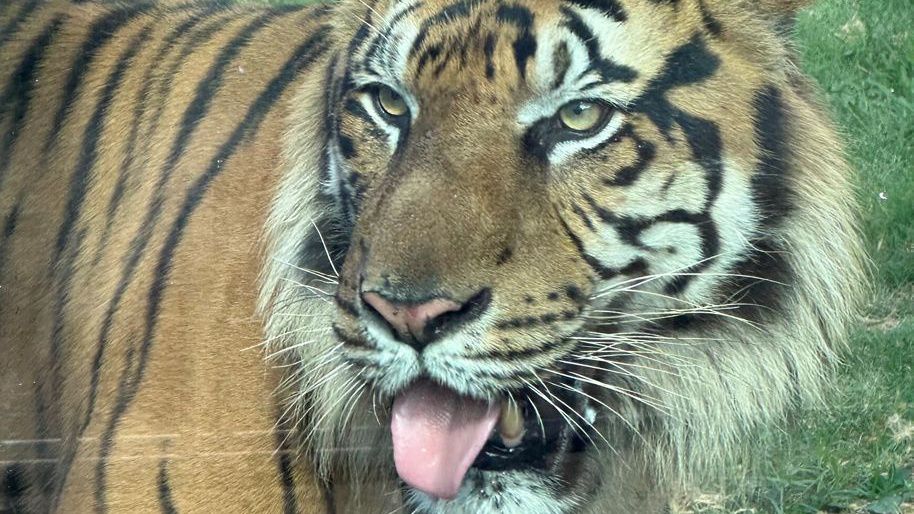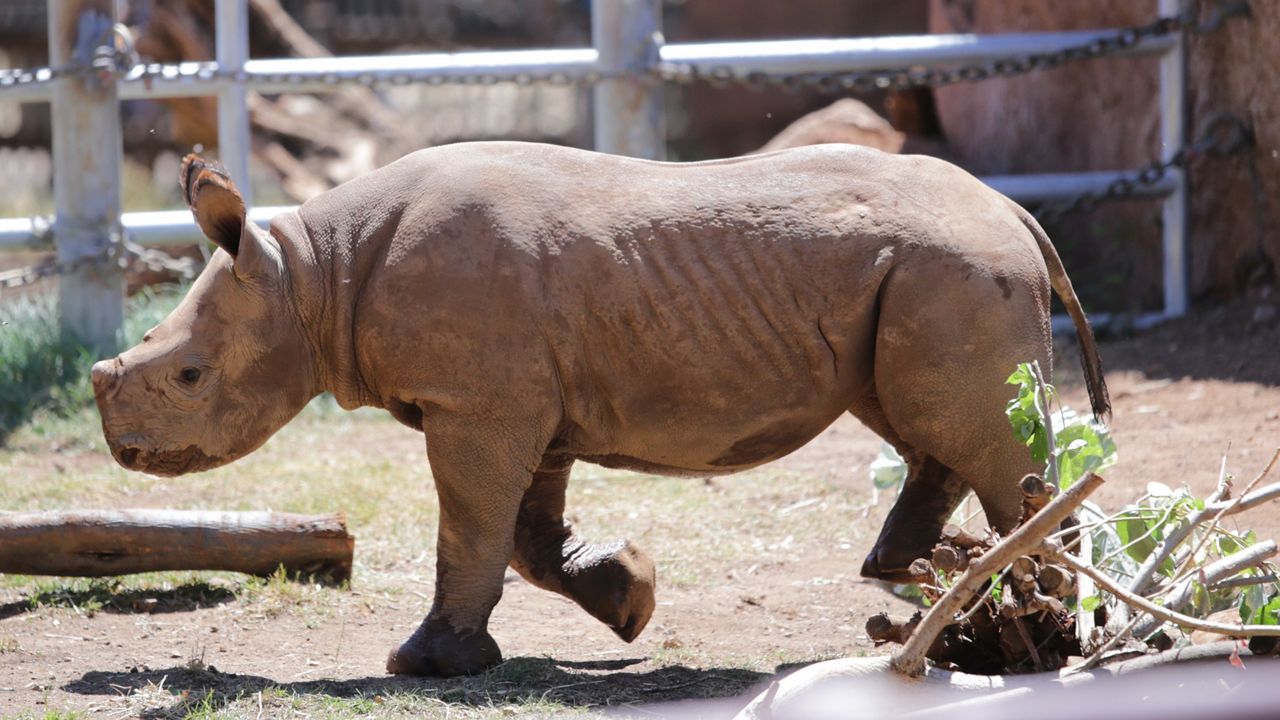Editor's note: This article is part of a series of end-of-year roundups that Spectrum News Hawaii will be publishing during the month of December. We hope you enjoy these reflections on local news in 2024.
All year long, Spectrum News Hawaii has been covering what is happening at the Honolulu Zoo. From arrivals and departures, the year at the zoo was an eventful one. Here is a look back at some of the biggest stories.
1. Honolulu Zoo celebrates baby rhino's 1st birthday with a party
First birthdays are a big deal in Hawaii. Many families host a baby luau for their keiki.
Well, the Honolulu Zoo honored this tradition and threw a party for ʻAkamu, the baby black rhinoceros born at the zoo on April 19, 2023.
For his first birthday, ʻAkamu received a cake from the zoo’s cafe, Kapahulu Market, and guests were given ice cream bars from Meadow Gold Dairies. Everyone sang “Happy Birthday.”
“We are all very excited that ʻAkamu is turning one!” said Honolulu Zoo Director Linda Santos at the time. “This is a significant milestone and we are pleased to announce that ‘Akamu is healthy, happy and growing very fast — so we felt a celebration was a must!”
Born to Aria (mom) and Kendi (dad), ʻAkamu is the first rhino ever born in Hawaii. Aria and Kendi came to the Honolulu Zoo from San Diego in 2022, after being identified as a breeding pair as part of the Association of Zoos and Aquariums’ Species Survival Plan.
If you would like to learn more about the three black rhinos at the Honolulu Zoo, read this special report on what it’s like to be a rhino zoo keeper.
2. The Honolulu Zoo welcomes Satu, an 8-year old male Sumatran tiger
On May 3, The Honolulu Zoo welcomed Satu, an 8-year-old male Sumatran tiger, from Miami. Satu weighed 229 pounds and previously lived at the Cameron Park Zoo in Waco, Texas. After a required 4-month quarantine, Satu joined 6-year-old female Anala, also a Sumatran tiger.
“We are very fortunate that the Association of Zoos and Aquariums’ Species Survival Plan was able to identify Satu as a genetically suitable match for Anala, our female tiger, as getting the right fit is always a challenge,” said Linda Santos, the director of the Honolulu Zoo. “We are all very thrilled to welcome Satu and hope that he and Anala will become a compatible pair.”
The Sumatran tiger is one of the smallest species of tigers in the world and are noted for their heavy black stripes on their orange coat. They tend to be shy and to avoid people in the wild. Palm oil, coffee and acacia plantations have taken over much of their natural habitat.

3. Four South American birds arrive at Honolulu Zoo
The Honolulu Zoo welcomed four vibrantly colored birds to its South American bird habitat.
On June 3, the zoo announced the arrival of one toco toucan and three scarlet ibises, who came from the Phoenix Zoo to breed with female birds at the Honolulu Zoo.
A male toco toucan named Guinness will be paired with the Honolulu Zoo’s female toucan Tutu. However, before breeding, Guinness, who is about to turn one, must reach maturity, which will happen when he is three-to-four years old.
The three male scarlet ibises, Larry, Moe and Curly, range in age from one-to-11 years old. Larry, Moe and Curly will join another male scarlet ibis at the Honolulu Zoo.
Honolulu Zoo’s wildlife experts hope the three new birds will breed with the eight females already living in the South American bird habitat. To attract a female, male birds perform mating rituals, which include popping of their bills, shaking, head rubbing and preening. Females will lay a clutch of three-to-five eggs, which incubate for 19-to-23 days.
4. Honolulu Zoo reopens primate islands after renovations
In June, the Honolulu Zoo announced the reopening of the Primate Islands Habitat after renovations.
The zoo’s ring-tailed lemurs and lar gibbon are enjoying the exhibit’s upgrades.
The Honolulu Zoo Society, a nonprofit focused on supporting the zoo, sponsored the $175,000 renovations. The refurbished exhibit includes a new viewing platform for the lar gibbon, a new bridge connecting two of the islands for the ring-tailed lemurs, new climbing structures and ropework, and new landscaping and rock work.
“We are very fortunate that the Honolulu Zoo Society earmarked funds raised at their 2023 Zoofari gala, ‘Primate Pāʻina,’ to support the modernization of this very popular primate exhibit,” said Linda Santos, Honolulu Zoo director, in a statement.
Mary Benson, Honolulu Zoo Society executive director, said when the lemur and gibbon were reintroduced to their habitat they were clearly excited, curious and happy about the renovations.

5. Honolulu Zoo sends chimpanzees to the mainland while exhibit receives improvements
The Honolulu Zoo announced on Oct. 1 that it had sent its last two chimpanzees to a zoo in Texas while improvements are made to the chimpanzee exhibit.
The zoo transported the mother and son pair — 49-year-old female, Kumi and 34-year-old male, Kibale — to their new home in Gladys Porter Zoo in Brownsville, Texas. Here, they joined a group of older adult chimpanzees.
Kumi and Kibale came to the Honolulu Zoo in 1994 from the St. Louis Zoo, along with three male chimpanzees: Roscoe; his son, Konakona; and Boo. Roscoe and Boo both died in 2021.
They all lived in the chimpanzee habitat with two other male chimpanzees, Nalu and Puiwa, who were born at the Honolulu Zoo in 1995 and 1999, respectively.
The Association of Zoos and Aquariums Species Survival Plan breeding program recently identified 30-year-old Konakona, 29-year-old Nalu, and 25-year-old Puiwa as genetically valuable and ready to start their own families.
The zoo transported Puiwa to Los Angeles in February 2022, and Konakona and Nalu to Dallas in June 2022.
The Honolulu Zoo chimpanzee habitat was originally built in the early 1990s and is slated for capital improvement projects that will involve renovating the viewing area and sleeping quarters.
While the exhibit is under construction, zoo staff will work with the AZA and its network of accredited zoos for the return of primates to the Honolulu Zoo’s African Savanna.
If you would like to learn more about the Honolulu Zoo’s breeding programs, read a feature about how the zoo breeds hundreds of Kamehameha butterflies.
6. Makamae is Honolulu Zoo's new mayor
There’s a new mayor at Honolulu Zoo after a weekend of voting in November — Makamae, the zoo’s native Hawaiian short-eared owl, won by a landslide.
The virtual election pitted Makamae and Jaws, a Galapagos tortoise, against one another as the public voted via hearts and likes on the zoo’s Facebook and Instagram channels. The election was designed to bring attention to the challenges these endangered and threatened species face, according to Honolulu Zoo.
Honolulu Zoo officials said Makamae is very honored to accept his role as Zoo Mayor. Gracious as he is, Makamae named Jaws as the zoo’s Director of Habitat Protection and Chief Conservation Office. He also tapped Jaws to lead a subcommittee as Czar of Birthday Shellebrations for their fellow zoo inhabitants.
“I want to congratulate Makamae on his recent win, HOOO I know will do a bang-up job as Honolulu Zoo Mayor,” said Honolulu Mayor Rick Blangiardi in a news release. “What a well-executed campaign from both candidates who ran on conservation platforms, including education, food sustainability programs, and trying to protect our planet from climate change. We stand ready to assist Mayor Makamae in any way we can to push these climate action and adaptation efforts forward!”

Michelle Broder Van Dyke covers the Hawaiian Islands for Spectrum News Hawaii. Email her at michelle.brodervandyke@charter.com.











